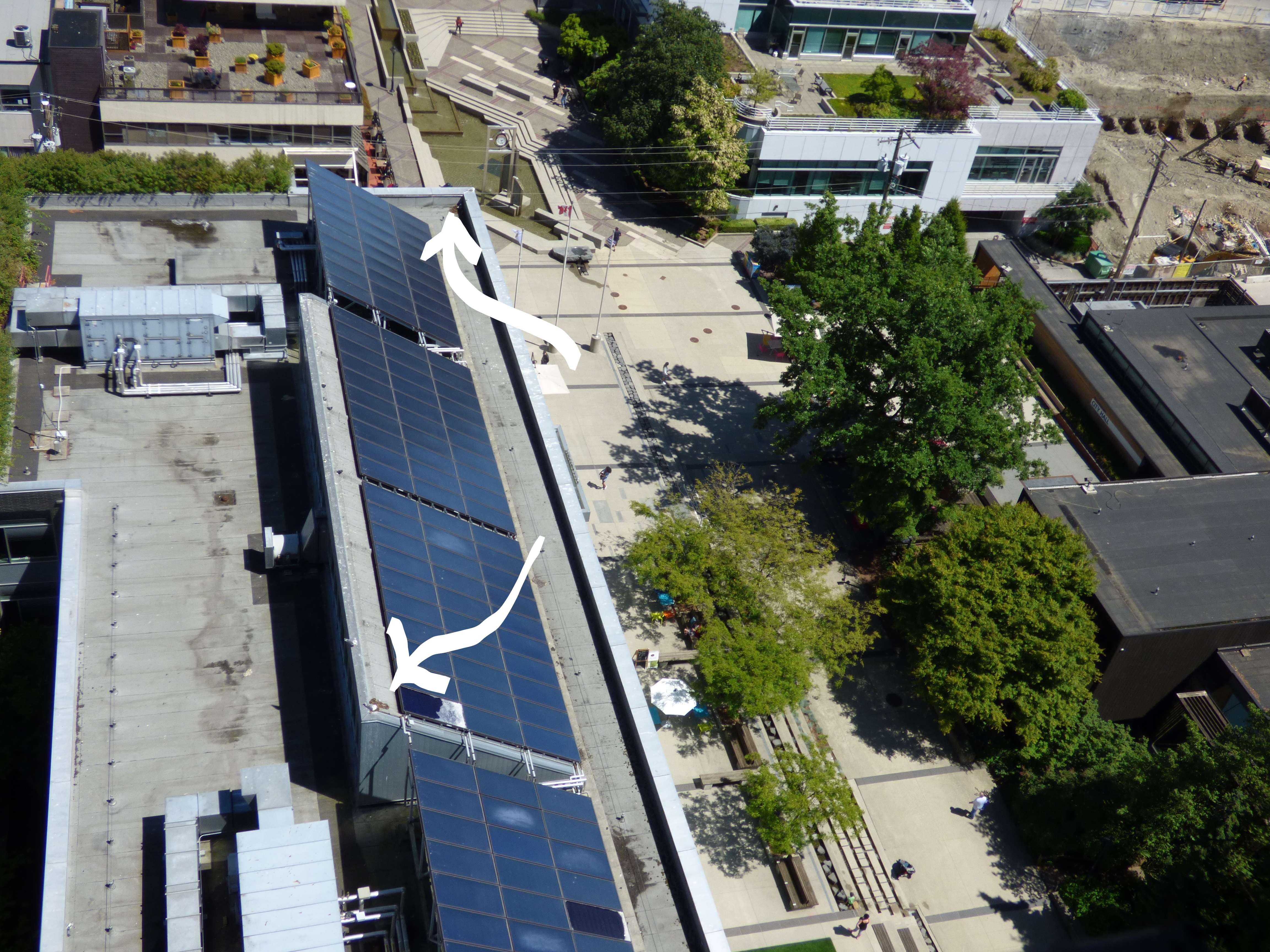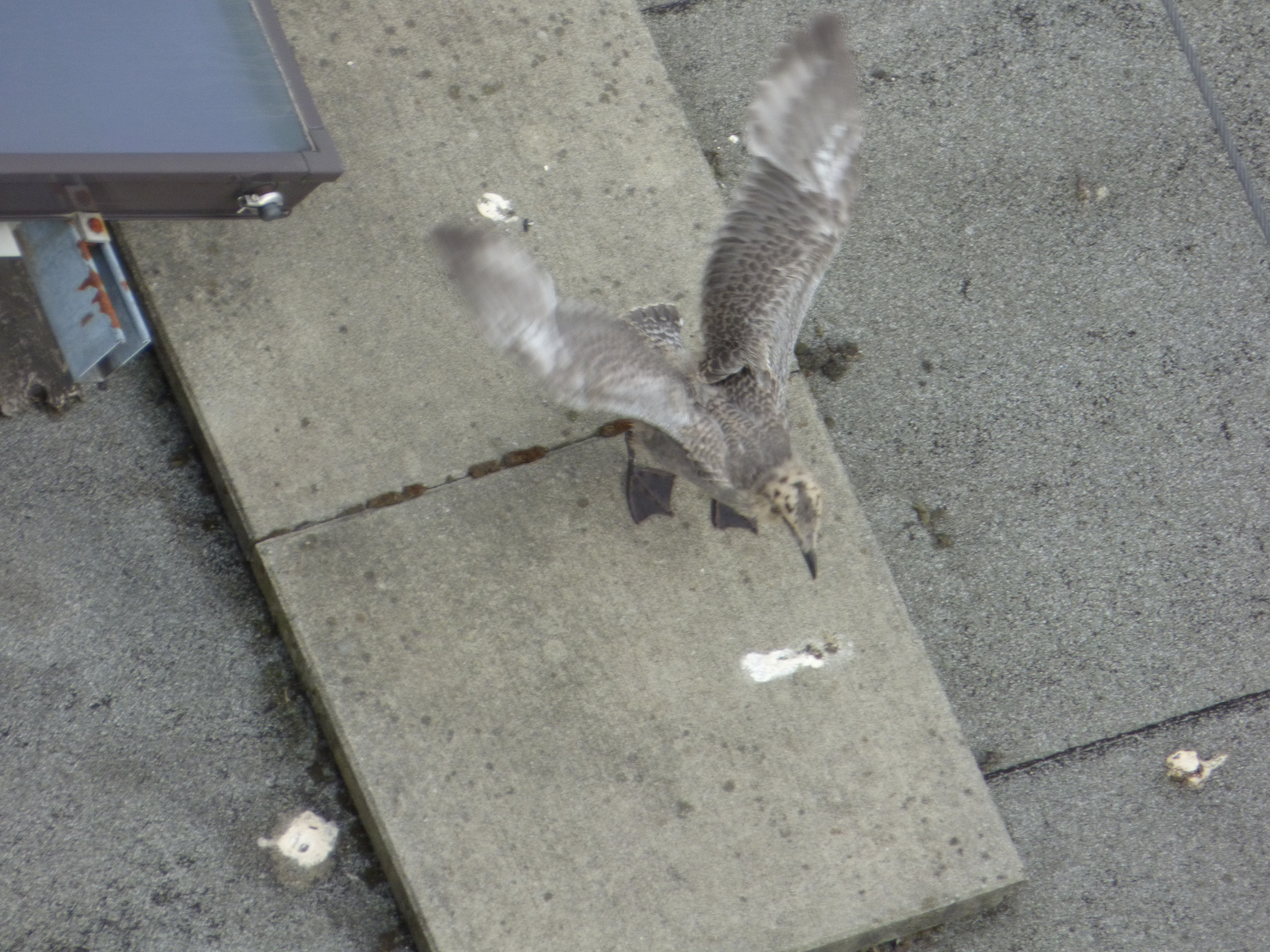Welcome to the World!
On July 1, Canada Day, the gull eggs hatched and we welcomed three mottled-brown nestlings into the world. They blended in so well with the nest, however, that it was hard to see them at first!
(If you missed last month’s article, where I introduced the gulls, please click here.)

Welcome to the world, little gulls!

The nestlings, born on July 1, Canada Day.
Apparently, gulls (these same ones?) have been nesting and raising their families in this same spot on the roof of the North Vancouver library, for years. Glaucous-winged Gulls (Larus glaucescens), they are the most abundant gull in British Columbia, making up about 75% of gulls in the province.
Here’s a wonderful photo of a Glaucous-winged Gull, taken by Pierre.

Photo by Pierre Cenerelli. Pierre’s note: I’m always glad when I can get a photo of this species eating starfish, which looks like a purple sea star (Pisaster ochraceus) to my untrained eye. Taken May 18, 2017, from the North Shore Spirit Trail in North Vancouver (British Columbia), Canada. In all of these photos, the gulls are wild and as shot, nor have they been baited, called in or set up.
From coastal colonies to urban rooftops
Most gulls live on islands or on the coast, where they nest in huge colonies, but the gulls on the library roof are city-dwellers, like me these days. Gulls started moving into cities when food at sea became scarcer because of over-fishing, habitat loss, and the rise of recycling, which dramatically reduced the amount of food scraps in the landfill sites where they scavenged. Some adapted by moving into waterfront cities that provided wasted food and roofs that could double as nest sites. As a result, populations of coastal gulls dropped by over half on BC’s south coast. http://www.forestry.ubc.ca/2015/03/seagull-populations-halved-since-1980s/
Most city gulls choose flat roofs but, as you can see, these ones selected a roof with precipitously sloping solar panels, and the nest sat on the flat outer edge. For weeks I worried about how the nestlings would manage the slope. I could just see them toppling down those panels!

The library roof with the nests in the corners
By their second day of life, already larger and more colourful, with black spots, they started to wander around the rooftop.

Parents feeding the chicks regurgitated food.
For the first week, both parents spent most of the day with their new family.

Mother returns to the nest. The chicks are two days old.

The family
Gulls make good parents
Indeed, gulls are known to be attentive parents. In A Noble Vision of Gulls (Living Bird, Summer 2016) Bonter and Shah write: “Human parents could learn a lot from gulls. For gulls, successful reproduction requires the complete attention of both parents, excellent communication and coordination ….” Check out their fascinating article here. It also includes an interesting short video about how gulls communicate, but that hasn’t helped me figure out what the gulls are doing when the sun goes down and they call loudly and repeatedly for hours. Right next to my open window.
Like all good parents, the gulls don’t feed their chicks junk food — even though the adults scavenge leftovers and garbage for themselves. Instead, the nestlings get protein-packed regurgitated food, mostly marine invertebrates the parents find at the water’s edge. Although kind of gross, regurgitation is the perfect feeding method for youngsters whose systems cannot yet digest food on their own.
Thanks to Pierre for this lovely photo of a Glaucous-winged Gull at the beach eating a nutritious lunch.

Photo by Pierre Cenerelli. Pierre’s comment: This gull was enjoying a crab lunch on Spanish Banks beach… I think this a Dungeness Crab (Metacarcinus magister), but I’m not a crab expert. Taken March 31, 2018 at Spanish Banks beach in Vancouver (British Columbia), Canada.
Independence Day
On July 4 the young began showing their independence, making their way along the edge of the roof, led by the parents, and hanging out near the corners of the building by themselves. I guess gulls are not afraid of heights!

Four days old
For the next five days, both parents were present most of the time, leaving their charges only periodically, for maybe ten minutes at a time. But the parents returned immediately if another gull got too close to the chicks. Then they were ferocious and tenacious in their chase, since Glaucous-winged gulls are not averse to eating other’s chicks for lunch!
Then, on the morning of July 6 when I looked out the kitchen window, two chicks had somehow made it from the nest on the top of the roof, down the sloping solar panels, to the lower roof! How did that happen?! Was it intentional or did they fall?
Later that day I saw the third chick, the smallest one, in the trough along the solar panel. He/she was there for over an hour. The parents took turns mewing at it, trying to reach it. I was frantic.

Don’t stop now. You can do it!
Fortunately, when I got home that evening, all three chicks were on the lower roof, safe and sound. Ever since then, I see them only once or twice a day for short periods. Most of the time they’re safely ensconced under the solar panels. I guess the parents knew what they were doing when they chose that nest site. What could be safer – and warmer! – than a solar-panel lined roof? The parents often huddle in the shade on hot days.

Staying cool in the heat of summer on a roof!
They also regulate their body temperature by “panting”.

Mother shading the chicks from the sun and panting to regulate her own body temperature
Every time the chicks did emerge, they were sleeker and bigger. By August 3, they were stretching their wings, getting ready for the big day, which was still weeks away. Now they’re using the roof as a runway to practice flying.

I feel the wind beneath my wings!
In the meantime, the parents and (perhaps) one of the parents from the nest at the other end of the roof, who started later and whose sole chick is significantly smaller, have taken to three-way “chats” in the evening while they wait for the kids to leave home at last.

Talking about the kids?
I’m waiting too, and hoping I don’t sleep late on the morning they finally fledge!
As always, thanks to Pierre Cenerelli for the gorgeous photographs!
To see more of his photos, go to: https://www.facebook.com/avesimago or https://www.instagram.com/pierrecenerelli/


